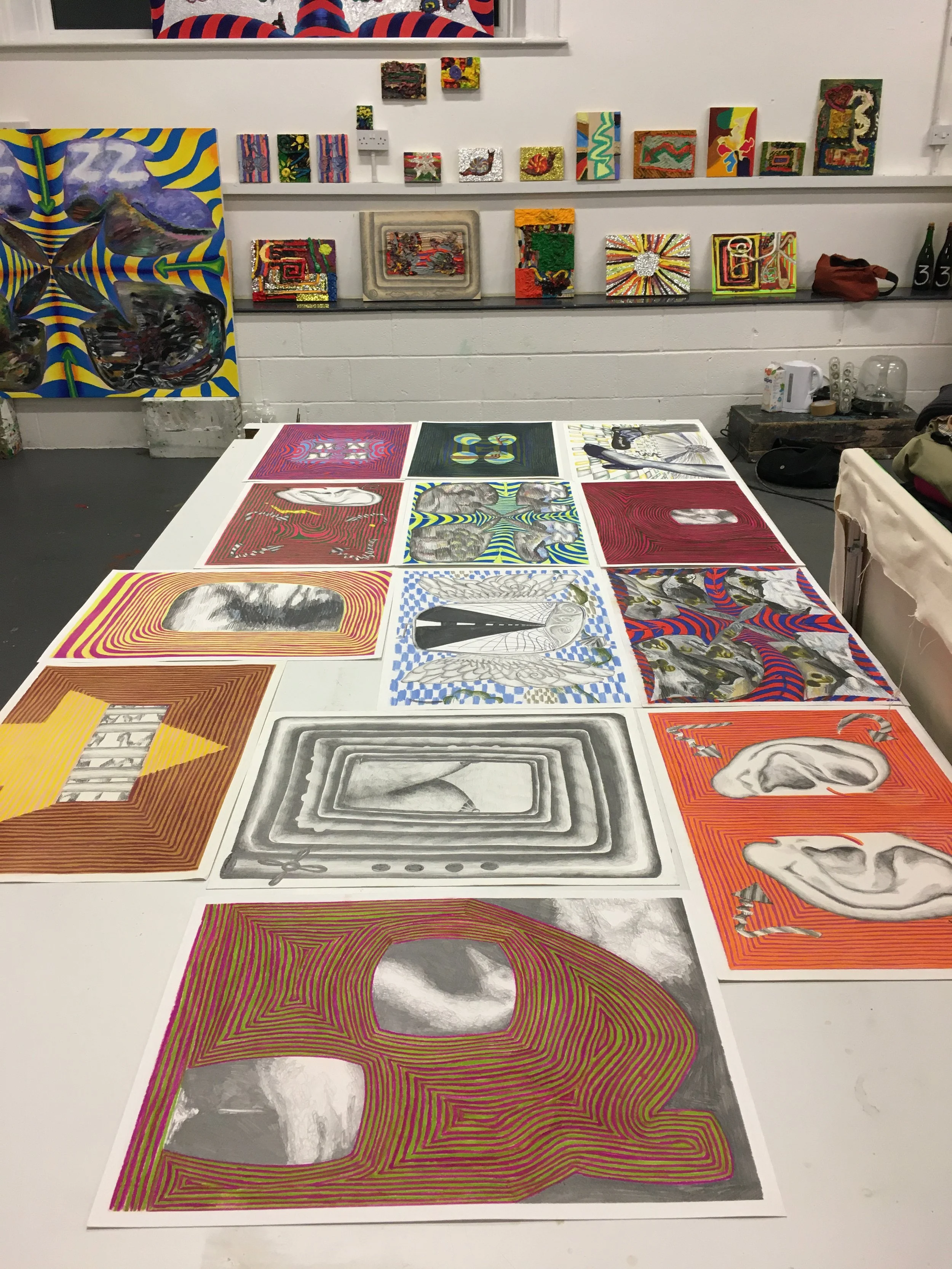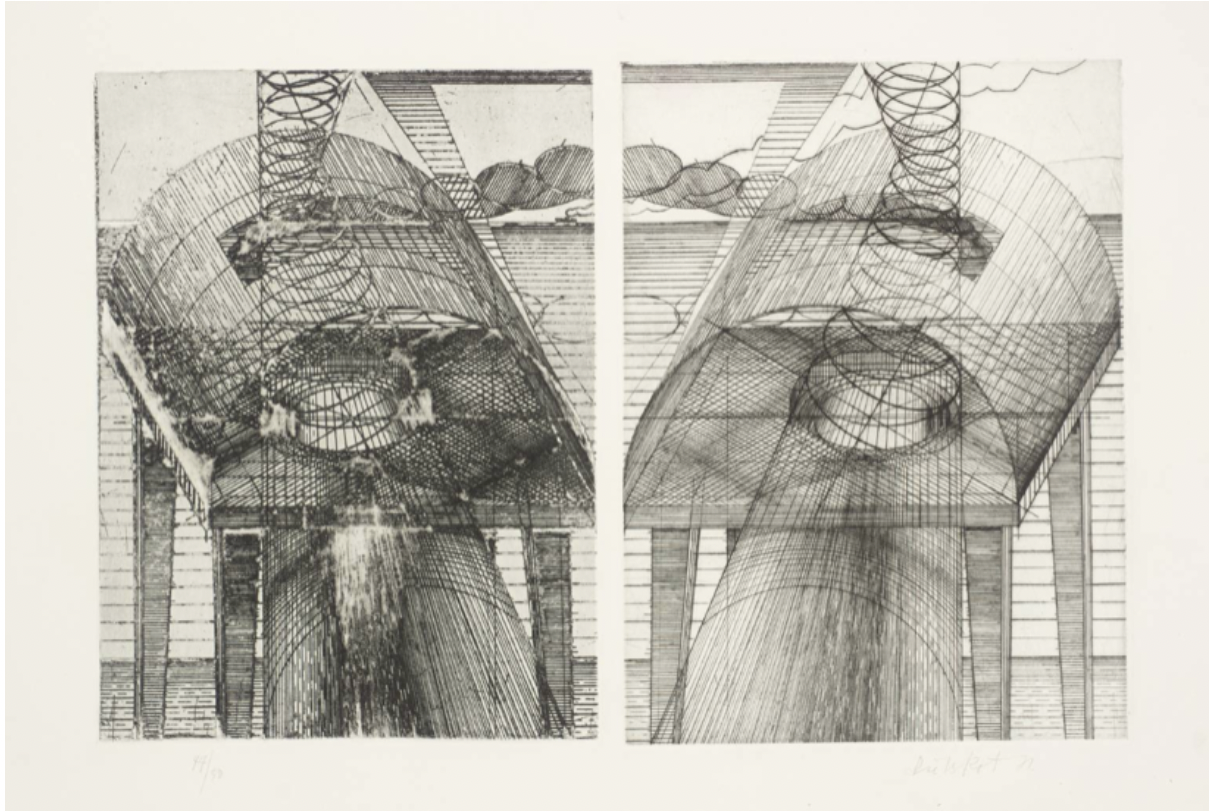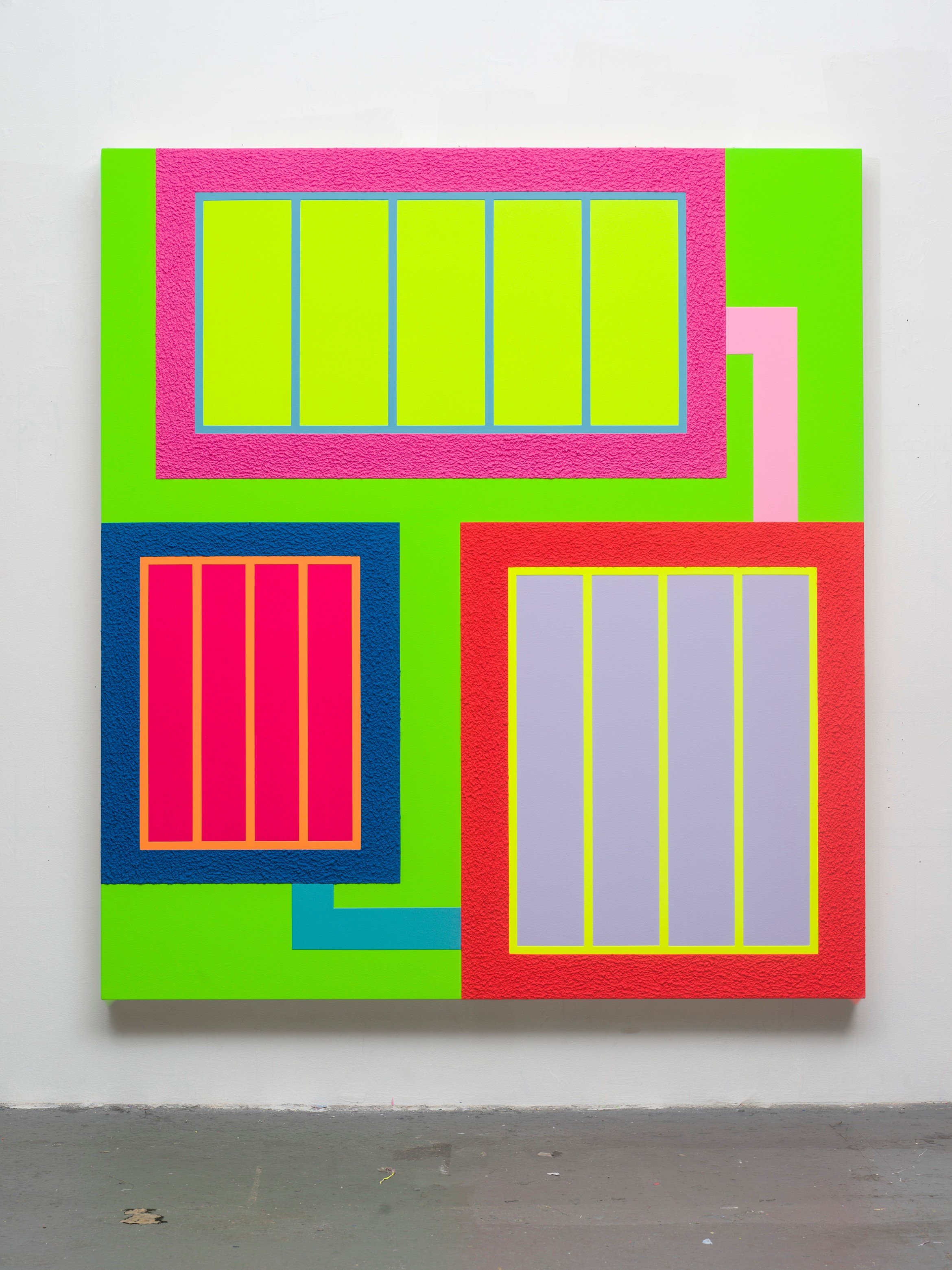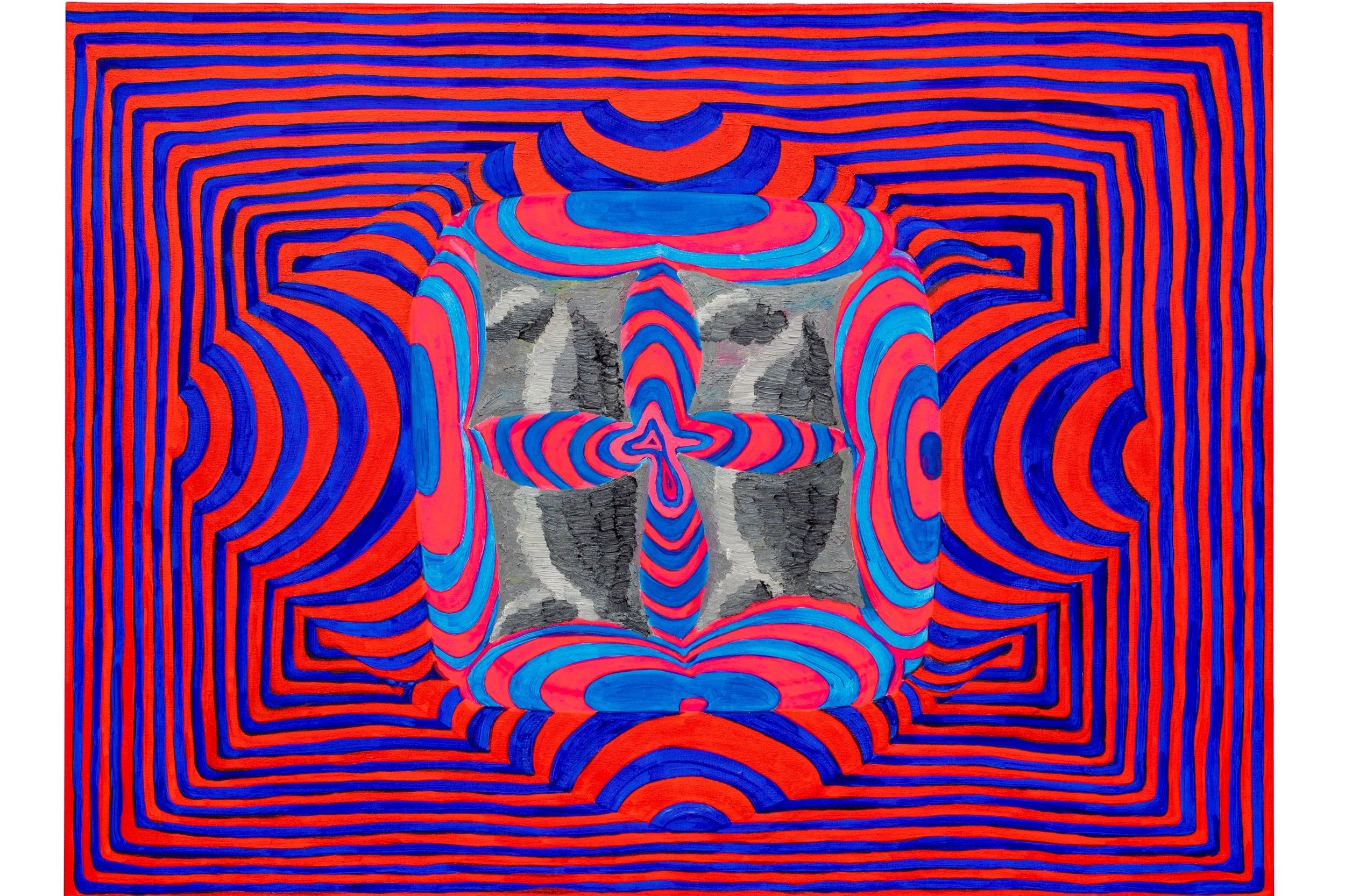Long Range Studio Visit
Suzy Babington + Jesús Crespo
This Long Range Studio Visit brings together two painters, Suzy Babington and Jesús Crespo.
They talk about a spiritual and trance like approach to painting and the preparations necessary for a more intuitive painting practice. The conversation covers their interest in light and how as painters they are able to imbue works with a luminosity through an understanding of colour and layering.
Suzy Babington
Suzy Babington works with the aim to feel some sort of refreshment, chasing radical forms, imagery and colour in the hope to create a surprise response within herself and continue a back and forth throughout working on the painting, the process akin to instinctual drawing. She welcomes seemingly surreal, impulsive imagery, creating fantastical fanciful narratives in-between fairy tales like ‘the woman and the shoe’ and real life apocalyptic chaos. The activity of painting becomes a challenge in how to execute a wild fortuitous image as she treats each painting individually. The works have movement like kinetic contraptions that pivot and support a complex structure with elements that interact as though animated like mechanics, the viewer can slip in-between different imagery which falsifies any certainty allowing the pictures to slip in-between different objects that often embody a dual aspect so things in the painting have multiple aspects.
Jesús Crespo
Jesús Crespo’s painting experiments with the relationships between metamorphosis, dissolution and extrapolation of images. His pictorial reasoning develops a work that combines different visions and creates a new meeting space between effect and discovery.
Ambiguity is a common place for his creations, in this territory his painting transcends the limits of the painting and it is the viewers who complete the work contributing their own interpretation to the symbolic game of his work.
Suzy Babington Hi Jesus. Nice to meet you. Pada put us together to do the interview.
Jesús Crespo Hi Suzy! Nice to meet you too! Perfect! We are connected then :) Thanks for writing to me!
SB How did you find pada and when did you go?
JC I was in PADA from April to July 2021. I knew about PADA thanks to my partner, she gave me the information online and we did some research. I was looking for residences and I saw that PADA offered a good space and program to develop a project and I decided to apply. Once here I wanted to take advantage of the space it offered to investigate the formats and size of painting, being able to paint in much larger formats and make different installations with my painting. So I did my research on paint, space, and layout. Tell me, when did you do PADA and what did you focus on once being here? Is the format important to you in your work?
Suzy Babinton studio shot
SB Ah that’s interesting. Must have been lovely working large scale! Format is definitely important in my work. I find bigger canvas’ have more potential for you to get absorbed into the activity, the process is large and lucid and fun.
Working at PADA though I made (slightly) smaller works due to wanting to transport them home and I worked in acrylic instead of the (very thick) oil that I would have usually used.
The limited time and change of material changed the process and pushed me to go to the finalised image quicker- and put less purpose in the pursuit of process or any taking apart of the works physically- as acrylic dries quickly so there’s less room to change. I also couldn’t fall back on the tactility of the oil paint so really it shifted my priorities to making something very flat and purely visual. I did a lot of drawings there in chalk pastels and found the value of drawing to work through a piece before going into the canvas whereas usually it would have been much more spontaneous, often starting from zero and experimenting.
Where do you start with your works? I see a lot of scrubbing out and layering perhaps?
JC Your assessment of large formats is very interesting and I agree with it. In my case, I give great importance to the immersive value that large formats have (for both the artist and the viewer). Whenever I can, I usually work in formats that exceed the human scale. The spatial experience in my compositions is key to understanding my work, perhaps I understand the smallest formats as a kind of window or drawers that give a clue about the infinite world that we can materialise through painting. This is because I understand my painting between the relations of expansion and possibilities, on the question of “When a painting is finished”, (maybe never?).
Jesús Crespo studio view at Pada
It is true that the drawing helps to structure the movements that we apply when we move on to the painting. In my practice I try to avoid everything that looks planned, such as recognizable images or narratives in drawings terms; it is the only way to obtain images that talk about the pictorial creation of the painting itself, that my brain has not predicted. I am also very interested in your appreciation of the tactile nature of oil. I always work with oil to give my paintings that sensuality and touch that oil achieves. Perhaps acrylic is less materially attractive in the sense that in our day to day we find an infinity of objects made of that material (plastic), perhaps that is why this material does not surprise me so much. Acrylic may be more sculptural than pictorial in value. Due to its ease of accumulation (layering) and the quick solution offered by its drying qualities. It is as if this material does not want you to hesitate when painting, and in my work doubt is essential.
What do you think of all this? Can you go deeper into the importance of tactile value or materiality in your painting and how it is related to your process?
Jesús Crespo, Night Sight, 162cm x 130cm, Oil on Canvas, 2021
SB Yeah certainly when I look at your work- there’s no pretension that the material isn’t paint. There's no point in the work where you’ve tried to make it ‘real’ or believable so it becomes an embracing of liquid errors or randomness. There's definitely something about embracing the physical ‘errors’ of the material- like don’t tidy it up, allow it to have these imperfections and embrace it to see what’s possible within that as a way to learn how to use the paint instead of trying to control it straight off. It seems somehow brash and crude in your work, like the works have been spewed out.
With the layering and scrubbing it feels like your works could keep malforming which I definitely relate to as though the process is more important than the end. I think it's a really good approach to just embrace every possibility or option in the faith that it would be useful and be aware you can get rid of it so it all becomes a learning thing. I find stuff you layer over sometimes can crop back up again down the line and you can make sense of it, or it has a chance to evolve and you can use it. I’m not able to look at something without trying- it feels crippling to go through considerations. Perhaps for both of us this malformation of the image becomes part of the language.
I can see Arrow Head Sculptures and lots of scrubbing out in your works. What do you think of painting as a battleground?
Who are your favourite painters?
I really like when you say the quick succession of marks is to obtain an image that your brain has not predicted, can you explain a little more about that?
Jesús Crespo ´Whistling in tongues´ 180cm x 120cm, Oil and acrylic on Canvas, 2021
JC It is very interesting all this sensitive appreciation that you indicate, just when you talk about your experience in the process of your work you can glimpse that sense of battlefield you ask me about. In my case of course it is, although I have never defined it with that word, since I think it is a word that carries very harsh connotations in our collective memory, as more associated with someone having to win or lose (painting or painter). In my case I managed to feel closer to a metaphor of the sexual act, since I understand that it occurs between two parties, through intense acts of contact but not to end the opposite but to enjoy it and reach a common summum.
This ties in with the idea of using those intensities in my pictorial process that help me precisely to avoid the idea or predefined image that my brain can harbour in the act of painting. The speed of the gesture and strategies such as opposing the pictorial intentions at the precise moments of the action help me to reach states of the image that I would not have been able to through a plan. Above all the critical moment is the beginning. Normally it arises through a form with colour, from then on that conversation between the painting and I usually begins, between form and meaning. But I do not feel this battle at a competition level, but at a trance or union level. I think my battleground would then be a bed.
What is your position as a painter in that battleground?
One of my favourite references is always Albert Oehlen, for the ease in the malleability of ideas that revolve around what it means to paint and the creative condition that this gives it. I would also tell you that Chaim Soutine and Francis Bacon, also Josh Smith, have projects that excite me a lot.
Which ones are yours?
Dietier Roth By the sea, 1971
SB When I think of a battleground, I think of this idea of taming a visual thing in your mind. As though the visual idea has had to be found, carved out and pinned down. It’s more like an attack! I like to think of it in a very cliche way like making jazz haha, or when rappers do freestyle. There's preparatory activities but the live event is emotional and chaotic. It feels like a meditation on the thing, working it out live and capturing it. Consequently for me this involves colliding imagery... I think of Dietier Roths drawings that have this impetus, like Ohelen certainly.
Peter Halley, Equalizer acrylic and Roll-A-Tex on canvas
I’m loving Peter Halley at the moment. At first for the visuals but he’s really interesting too. He’s interested in urban/man made forms. Calls his paintings ‘cells’ and thinks of them in really simple terms: containers with these connectors to the outside, like houses with electricity and water... But he’s interested in this nature of our urban environment that we don’t see under the ground through pipes and networks too, where there’s another universe of jungle-like systems with this clinical blocked out tidied up surfaces that we are presented with above ground. The work goes back to De Stejl the Dutch movement of lines and composition... And then his blinding day glo colour that vibrates back at you with so much intensity.
For me pure colour has got that immersive, experiential thing that you can only parallel with a natural landscape. I’ve been working with dense stripes at the moment, it’s a slow process going around in circles with a continuous line but I find real value in the colour reaction on that dense level. It becomes hallucinogenic like the process of painting.
The stripes play with your eyes in person. To be honest with some- I can’t look at them too much because they leave an imprint on your retina. I really like to imagine how a butterfly would feel going up to a flower on a micro level so for me doing big paintings with these colour reactions is trying to create this experience. The idea of placing two colours next to each other in a simple form for me mimics screens built from micro lights as well as natural forms like when you see scientific images of close up natural patterns. Then from far out they operate differently and I can play with imagery more within that... creating more 3d ideas.
Suzy Babington, 401 Unauthorized, 120cm x 90cm, Acrylic and oil on canvas, 2021
I’m also really enjoying Judy Chicago’s abstractions. She says making work is ‘through the flower’. She relates it to womanhood and a female perspective of painting. The main idea is that the work is pushed through your being. It’s a spiritual approach to making images as it talks about what place the works come from. Perhaps rather than having random, accidental or surprise elements to create spontaneity- it comes from a spontaneous place. I just really love the realisation of imagery as though it embodies a sort of ‘gong’ moment like when a Buddhist finds enlightenment or someone takes a psychedelic drug, or how I imagine she might have felt finishing/realising the painting. It’s like you’re looking into infinity on a huge level, or through a microscope on a tiny level. There's this mathematical pattern to it that you find in nature.
Perhaps it’s the portal aspect I relate to. These floral shapes for Judy or tubes for me create doorways or surrounds. It could be dealing with ideas of escape/transience/transformation in a simplified cartoon like way, that doesn’t dumb down the idea... but expresses its simplicity.
Suzy babington, 400 Bad Request, Oil on canvas, 120 x 160cm, 2021
JC Really interesting what you say about the spiritual approach and I can see it in your work too. It's a really deep theme to treat, because I feel something like that but that feeling is the hardest thing to communicate, at least in my practice. I understand it in my process as a trance and I notice that the painting is kind of finished when a "voice" or "whisper" comes from the image. Then it is true that from that point everything is becoming calm. I love that point Suzy, so happy that you found it as well in your way.
In reference to Trance I was researching about the meaning of the spell, and the role of the artists today as a sorcerer. That is why I have been working with the idea of fire as a tool to illuminate my paintings, but the fun thing is that the fire in my work is an illusion (as all painting is) so it comes from the painting itself, just leave yellow and red together and suddenly we can perceive fire and therefore light.
The torch is made with fabrics and wood that are around my studio. I tried to capture the energy that helps to burn that light that allows us to glimpse what is not apparent in reality, and in my case through painting, hence it is composed of elements that are close to the painting.
Jesús Crespo Torch
SB Yeah trance is a really good word for it.
Ah I see! They are torches. If the fire painting is the spell, are the torches the wand? I’m kind of joking but it could be!
I really like the idea of painting light. It's obviously a really traditional thing to be concerned with light but it feels like when you are painting fire, or someone paints a star, suns, even domestic lights- it feels like the idea of light has evolved into just painting the source of light itself. Like a simulacrum, going in circles. Like you say, a metaphor for painting as an illusion too.
Funny that I think of my stripes like light cells on a screen.
There’s the need to reduce as an artist. The marks have found their form in the fires and clicked into place so the contents of the painting feels whole.
JC You are not so far from the idea of the wand, I had never reached that conclusion but precisely in one of the group critiques that we did in PADA I held that torch in my hand while introducing my paintings and I think I got to point out my works with it.
In everything you say about light, I totally agree, it is obvious that it has been one of the reasons that has accompanied the history of painting. In Spain we have a lot of painters who have squeezed and played with the idea of light, such as Goya, Velázquez or Sorolla. They were great pursuers of the atmosphere of their painted scenes, a part of using it conceptually for its symbolism.
In my case it started from a kind of meta-painting game, as you indicate, one of my gestures found its perfect shape but it was the colour and the de-contextualization of the gesture that managed to close that idea. You often find that gesture in my works, but as it contains other colours, it is not usually identified as fire. Thus I managed to create a kind of trompe l'oeil where adding yellow and red would create the illusion of fire in a very precise formal adaptation. By repeating this idea on different supports (not only canvases, but objects that were found in my studio such as old notes from life from my university days, everyday objects such as food cutting boards, boxes or small coolers among others objets) they served me as noble material to "burn" my action. This is how I got a composition of 72 pieces that ended up being titled Hoguera (Bonfire).
Jesús Crespo, Hoguera, Installation of 73 pieces of various supports. acrylic oil and spray on wood, fabric, pvc and paper,
250 x 550 cm, 2021
Either way, I think it makes perfect sense on these topics that we discussed the research you did at PADA on colour stripes. In my opinion, of course they work as light in your works. It leads me to think about the idea of light colour of the screens. There is a very famous effect in the new media languages that they call the echo chamber effect; this creates a signal repetition effect that builds a kind of tunnel or psychedelic vortex that can be seen in your paintings. And as we have spoken, it links very well with a direct spiritual sense, with the mental world and perhaps also a brain image, of nerve endings.
And the most interesting thing is that the effect of repeating patterns alternated with colour stripes in your paintings, apart from working as a suggestion of an afterlife in which the idea of light (both symbolically and literally) is always latent, they work in the paintings, maintaining pictorial values of composition, color, matter, etc.
I really liked this work of yours, I think it is wonderful and I was wondering if the central triangular image comes from some image or silhouette or have you reached it in the process?
Suzy Babington, 502 Bad Gateway, 110cm x 140cm, Oil on canvas, 2020
SB Yeah this one did evolve. It was originally on its side like an arrow only with the central “spine” and curved cone top. I ended up building the body of it down and around the spine. I always start these stripe ones from the outside and follow the line into the middle- its two lines all the way through rather than squares going into each other. Then whatever line hits the shape, dictates the form. I really like the release of control. The painting takes its own way and in the end the line forms become holographic.
I’ve never heard of the echo chamber effect but it makes a lot of sense. I think of lines from inside a tree or water ripples.
There's a documentary on Netflix at the moment called the colours of infinity. It's pretty funny and retro… About the Mandelbrot Set a mathematical formula that generated a truly infinite series of patterns. It really is amazing and feels like it defies your sense of logic.
Beautiful light in those paintings. Particularly that Sorolla- It feels like the moment is arrested by the light. These old paintings are so spooky when you feel transported to that place. Like your primordial fires- They are evading time.
Thank you to Suzy Babington and Jesús Crespo for discussing about their experience at PADA.
Suzy was a PADA Resident in 2020 and Jesús in 2021.













